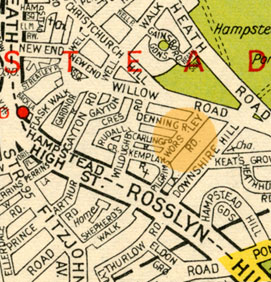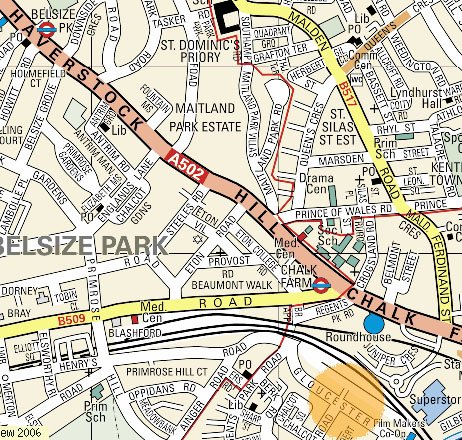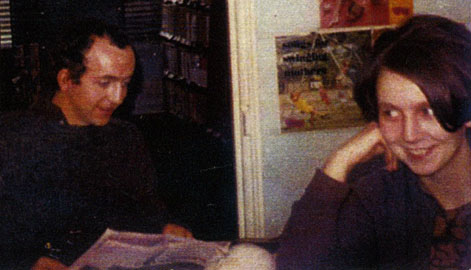Courtesy Rosemary Hale and
the Burmese Cat Club
Procul Harun's birth-street
Procol HarumBeyond |
|
|
PH on stage | PH on record | PH in print | BtP features | What's new | Interact with BtP | For sale | Site search | Home |
|
[Read the
first, fascinating episode of this Procol cat-hunt, before proceeding]
A few e-mails and 'phone calls to Maureen
Smith and Margaret Somers at the Burmese Cat Club lead to me being put in touch
with that august organisation’s Rosemary Hale.
Over the 'phone, and later by letter, she tells me
I’m not the first to have asked her about Procol Harum, though the last enquiry
she received was a few years ago and didn’t seem to lead anywhere. With
considerable patience and good humour, Rosemary explains the history of the
Burmese breed in Britain, and provides me with much illuminating anecdotal and
documentary information about the subject of my enquiry. The online database is
a lengthy work in progress – cats breeding like … well, cats – and it turns out
my quarry’s details have simply yet to be added.
The Chapmans
‘The band Procol Harum was named after a Blue Burmese male
cat named Procul Harun,’ confirms Rosemary, after consulting the registration
document and pedigree certificate the Cat Club was bequeathed when the cat’s
breeders died in the mid Eighties. So the band did have access to the genuine
pedigree certificate, after all … they just didn’t take notes.
Mrs Eleonore Vogt-Chapman and her husband were among the first to breed Burmese in Britain. (Eleonore was of Scandinavian origin, and Vogt was her maiden name.) Different breeders register and claim sole use of a particular prefix, and the Chapmans used Procul for all their cats. Various online dictionaries inform me that it is indeed Latin, and can be translated as ‘far away’ or ‘from a distance’, which is appropriate enough for a breed of cat that had already travelled to Britain from Burma via the USA. Given the wide variety of suffixes afforded the Chapmans’ cats, though, it would be a mistake to impose a Latin interpretation on their full names.
Procul Harun
The other kittens in Procul Harun’s litter – his only full
siblings – were named Procul Hussein and Procul Lady Sonia. All that the three
suffixes have in common is a (very) vague nod to the breed’s Eastern origins and
a tendency to flatter. Sonia is originally a Greek name meaning sensible or
wise. Hussein is Arabic, meaning good, handsome or fair. Although the name Harun
probably originated in Egypt, and – typically for anything associated with
Procol Harum – is of unknown derivation, it is the Arabic version of Aaron. As
Aaron was the older brother of Moses, the Hebraic interpretations of the name
have held sway. Given the familial association with mountains, most are
variations on a theme of loftiness and exaltation.
|
|
Procul Harun’s pedigree certificate – click to
enlarge Courtesy Rosemary Hale and the Burmese Cat Club |
| Click map to find Procul Harun's birth-street |
The exalted one from far away was born on 19 June 1964, at 253 South Avenue, Abingdon in Berkshire. He was registered with the marvellously named Governing Council of the Cat Fancy on 14 October that year, and given the registration number 128858. ‘His sire was a Blue Burmese, Champion Ballard Bilin,’ says Rosemary Hale, ‘and his dam was a Brown Burmese, La-Sun Harmony.’ Harun’s brother Hussein was Brown, his sister Lady Sonia was Blue. It was to be the only Procul litter for which Ballard Bilin was the sire, for purely practical reasons: ‘Ballard Bilin lived down at the bottom of Dorset, and that would have been a very long and tedious journey from Abingdon at that time with a calling queen.’ Followed by a return journey to pick up the hopefully pregnant female a week later …
Mrs Coombs
Breeders were obliged to keep cats for at least three
months before selling them. A scrawled note on the back of Harun’s registration
document reads: ‘Mrs Coombs. 12a Worsley Road, Hampstead. Olympia. £10.’ From
this it’s reasonable to deduce that a Mrs Coombs of that address first saw him
at the National Cat Club’s show at London’s Olympia in December 1964, and became
his new owner shortly afterwards.
Rosemary Hale finds an annotated programme for the Olympia show among Mrs Vogt-Chapman’s papers. All three kittens from Harun’s litter were indeed shown. Harun himself, number 438, came a not particularly distinguished third in his class of kittens. The £10 Mrs Coombs paid for him is roughly equivalent to £140 today. There’s no record that she ever sold him on, so this suggests Mrs Coombs was probably still his official owner when the cat’s name was appropriated by the band in early 1967.
|
Olympia 1964:
Page from |
|
Cat-loving Procol Harum fans should now prepare themselves for a series of disappointments. Although no official records of death are kept, Burmese live for an average of 17 years, and into their early twenties at best. So Harun would have been lucky to see out the Eighties. All three kittens in his litter were sold as pets, rather than to breed. Which means they would probably have been neutered around six months of age, thus dashing any hopes of owning a direct descendent from either Harun or one of his two full siblings. (Harun’s dam did give birth to a further ten Procul cats – Harun’s half-siblings – between 1964 and 1969, though, and his sire … well, tomcats will be tomcats ... )
 |
 |
|
Worsley Road (left) becomes Pilgrims' Lane (right) |
|
Again typically for this investigation, Worsley Road no longer exists. It was incorporated into Pilgrim’s Lane in 1969, at which point the houses were renumbered. Number 12a Worsley Road became 56a Pilgrim’s Lane. The address doesn’t appear to be likely roadie or drug dealer territory: politician Michael Foot was a Pilgrim’s Lane resident at the time, and still is. But the flat Guy Stevens shared with his wife Diane at 23c Gloucester Avenue, a popular party venue, was just a couple of hundred yards away down Haverstock Hill.
| Location of Gloucester Avenue: click map to explore the area |
 |
Tubs?
‘I was always told that Mrs Coombs was the mother of a Procol
Harum band member,’ offers Rosemary Hale. While this isn’t the case with regard
to the official early line-ups, numerous musicians auditioned for or were even
briefly members of Procol Harum during Guy Stevens’s tenure as manager; and some
of their names have been forgotten even by the core members of the band, such as
the near legendary drummer known only as ‘Tubs Drubs’, despite having played on
the demo of AWSoP. A connection of some sort via one of the musicians in
the Procol-Stevens circle is at least theoretically possible, then.
Googling different spellings of Coombs with various combinations of Procol Harum and Guy Stevens throws up one possible candidate: Rod Coombes. Coombes had drummed for Lulu’s backing group the Luvvers, then George Bean and the Runners, where he replaced future Procol Harum drummer BJ Wilson, and then briefly with another of Guy Stevens’ protégés, Spooky Tooth. A drummer. Mmm. It’s worth an e-mail, which eventually brings the following response: ‘Unfortunately, although I lived in Hampstead – that’s quite a coincidence isn't it? – I never had such a cat, sorry.’ Shame. For a tantalising couple of days, I’d allowed myself to think I might have traced not only the cat’s owner but also Mr Drubs himself. Though, thinking about it, Brooker and Reid would surely have remembered a Tubs-tabby twofer.
Everyone
Via the London Metropolitan Archives website,
I pay for a check on the electoral rolls for 12a Worsley Road, 1965 to1969. In
the two weeks it takes for the information to arrive, I put in a request to talk
to Gary Brooker via the PR company handling the band’s fortieth anniversary back
catalogue reissue programme on Salvo/Union Square. I also contact Roland Clare
at 'Beyond the Pale' and ask him to pass on
e-mail requests to talk to Keith Reid
(though he doesn’t think much of my chances) and former Procol Harum organist
Matthew Fisher. When I apprise him of my quest, and tell him I think I’m nearly
there, Roland unintentionally takes some of the wind out of my sails. ‘I got 90% of the way
there too, I think,’ he e-mails back. ‘But it was several years ago, and I didn’t
write it up.’ Oh. It sounds very much like he was the last person to go knocking
on the Burmese Cat Club’s door.
 |
Diane Stevens (right) with Guy Stevens |
Guy Stevens died in 1981. By cross-referencing information supplied by Mott the Hoople biographer Campbell Devine with current online directory information, I find a likely 'phone number for Guy’s widow Diane. Three separate attempts go straight through to the answering machine. I finally leave a message, but never receive a reply. There’s a thin line between dogged persistence and stalking, so I leave it. Covering all the other bases, I e-mail Ian Marchant to ask him about Ash.
Matthew Fisher gets back to say he was hired after the naming of the band, at a time that Guy Stevens was already fading into the background. ‘I have seen the actual pedigree certificate. The cat was called Procul Harun,’ he confirms. ‘Never met the guy whose cat we were named after. And Coombs doesn’t ring any bells. I think Keith got the misspelling of Procul from a proprietary cold cure – similar to Contac 400 – which I've just discovered is still out there.’
‘It was quite early on when the band was named,’ recalls Gary Brooker over the 'phone from France. ‘I think it was when we were rehearsing in Camden, a church hall sort of place. Before we moved to Stockwell. I have a recollection of the name being suggested over the 'phone, but – come to think of it – why would there have been a 'phone there in those days? We didn’t expect so much interest in the name. It became another mystery. An enigma. I remember seeing the pedigree certificate. It was in a newspaper, I think.’ He doesn’t recall anyone called Coombs either. ‘I thought the cat owner’s name was Bob. Can’t remember his surname.’ Bob? Now we have a Bob?
Elisabeth and
David
The electoral roll search for Worsley Road
turns up no Bobs, but does reveal that Elisabeth A Coombs shared the flat at 12a
with David Rhys-Rowberry. Given the times, this suggests a younger unmarried
couple: Miss rather than Mrs Coombs, with her partner being perhaps the more
likely link to the band. Although still at the address in 1965, they had left
before the naming of Procol Harum.
The online directory fails to offer a 'phone number or a more recent electoral roll listing for either name. I do find a 'phone number for a David R Rowberry, and call it on spec … but when his wife answers and tells me his name is not David Rhys Rowberry but David Robert Rowberry, I offer her my apologies and end the call without bothering him. There’s nothing useful in the easily searchable part – 1984 onwards – of the online births, marriages and deaths registers, either. Googling Elisabeth Coombs divulges a lady of that name currently involved with the Anglican Church in Exeter. What the hell. ‘Unfortunately I am not that Elisabeth Coombs!’ she replies to my e-mail. ‘Coombs is my married name.’
Rowberrys
Googling variations of the then-partner of the other
Elisabeth throws up another intriguing possibility: Dave Rowberry, who replaced
Alan Price as organist in the Animals… one of several R&B bands with which Guy
Stevens had a close relationship. Rowberry’s 18-month tenure in the Animals came
to an end at the end of 1966, around the time Brooker, Reid and Stevens began
looking for musicians to form Procol Harum, and before they found Matthew
Fisher, so he might, conceivably, have tried out for the band around the time of
its naming. Rowberry passed away in 2003. Checking the registration of his birth
reveals no trace of ‘Rhys’, whether as a subsequently dropped double-barrel, a
middle name, or a mother’s maiden name. This looks like a dead end.
My searches also throw up Nicky Rowberry’s 'Peasants to Puddles' family history site. Rowberry is not a common name, apparently, and has strong links to the Hereford area. As Hereford abuts Wales, that might explain the ‘Rhys’ and perhaps even the location of Ian Marchant’s meeting with Ash. There’s no mention of a David Rhys-Rowberry on the site itself, but I e-mail Nicky David and Elisabeth’s details along with an age guesstimate. She can’t help, but suggests I try another Rowberry family historian named Polly Rubery …
This ongoing article is
© Marcus Gray October 2007, and is reproduced by his kind permission.
Enquiries, further information etc, to red.barn at yahoo dot co dot uk
In addition to an AWSoP retrospective for Classic Rock, Marcus Gray is the author of the sometimes-acclaimed Last Gang In Town: The Story And Myth Of The Clash, the occasionally-remembered It Crawled From The South: An R.E.M. Companion, and the deservedly-forgotten London's Rock Landmarks.
The Name of the Cat | The next instalment of this story | The previous instalment of this story
|
PH on stage | PH on record | PH in print | BtP features | What's new | Interact with BtP | For sale | Site search | Home |